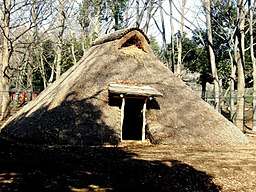Kurihara Ruins
| Kurihara Ruins (栗原遺跡) | |
| Reconstructed pit-house | |
 | |
| Country | Japan |
|---|---|
| Region | Nerima Ward |
| District | Tokyo |
| Elevation | 37 m (121 ft) |
| Coordinates | 35°45′16.877″N 139°40′20.442″E / 35.75468806°N 139.67234500°ECoordinates: 35°45′16.877″N 139°40′20.442″E / 35.75468806°N 139.67234500°E |
| Material | Thatching and wood |
| Originally constructed | AD 710 to 794 |
The Kurihara Ruins (栗原遺跡 Kurihara iseki), shown on some maps as the Shirokita Central Park Kuirhara ruins, are ruins of a pit-house in Nerima Ward, Tokyo, Japan.
History
The ruins were excavated when constructing the athletics and exercise area of Rikkyo University (立教大学 Rikkyō daigaku) in 1955. The name Kurihara comes from a small administrative unit of a village that existed in the area. In a survey conducted between 1955 and 1956, stone tools made of obsidian were excavated from the red soil (Kantō Plain loam), and were found to be from the Paleolithic age. Also, Jōmon pottery has been excavated, showing that traces of pit living from the Yayoi to the Heian periods (300 BC–1185 AD) have been found. The reconstructed dwelling depicts a construction from around the beginning of the 8th century, the early Nara period (AD 710 to 794). The reconstruction was designed by Gaijiro Fujishima, then a professor at the University of Tokyo, in 1957.
Structure
The pit-house has been dug out to a depth of 50 cm and there are four pillars made of Japanese chestnut (Castanea crenata). The beams are made of Japanese zelkova (Zelkova serrata). Inside, there is a fireplace and hearth.
Image gallery
 The site in November 2015
The site in November 2015